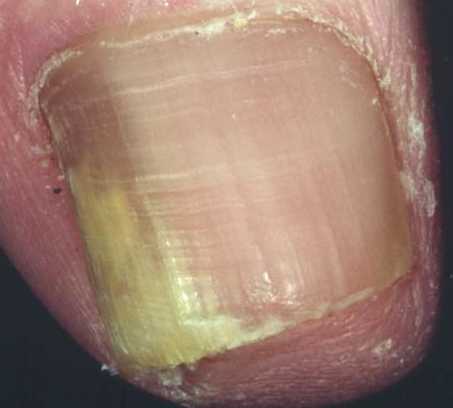Fungal infections of the fingernails or toenails are common globally and relatively mild, but can have an impact on quality of life (Gupta & Mays, 2018). In rare cases they can spread to other tissues in severely immunocompromised individuals.
Specimen collection is of great importance to achieving the correct diagnosis and choice of treatment depends on which species is involved.

Patterns of onychomycosis


Videos & clinical images
Mycology Specimen Collection
Onychomycosis that fails terbinafine probably isn't T. rubrum
Onychomycosis | Nail Infection | Signs, Symptoms, Treatment


Onychomycosis of three fingernails caused by T. rubrum 
A very typical example of lateral onychomycosis on the great toenail 
Superficial white onychomycosis, typically caused by T. interdigitale or C. albicans 
Onychomycosis in AIDS, with evidence of localised skin involvement 
Another example of onychomycosis of the great toe, perhaps the commonest pattern 
Chronic Candida onychomycosis (part of chronic mucocutaneous candidiasis) showing a normal 5th fingernail, a hardened touch 4th fingernail, a completely destroyed 3rd fingernail and an infected and deformed index fingernail

Factsheet
| NAMES Onychomycosis; Tinea unguium; fungal infection of the nails; paronychia |
| OVERVIEW Fungi may affect the nail fold (paronychia) or the nail itself (onychomycosis). Toenails are more commonly affected than fingernails. Discolouration of the nail, either in part of completely is typical. |
| FUNGI Paronychia is usually caused by Candida albicans and occasionally other Candida species. Onychomycosis is caused by a wide variety of fungi especially T. rubrum, which causes about 80% of cases in the UK. Non-dermatophyte moulds that occasionally cause onychomycosis, usually of the toenail, include Fusarium spp., Aspergillus spp. (reviewed by Bongomin et al, 2018), Acremonium spp., Alternaria alternata, Scytalidium dimidiatum, Scytalidium hyalinum (Nattrassia mangiferae), Scopulariopsis brevicaulis and Onychocola canadensis. C. albicans and, rarely, Candida parapsilosis cause onychomycosis, especially superficial white onychomycosis. Some infections are caused by more than one fungus. |
| GLOBAL BURDEN Fungal nail infection (onychomycosis) is common in the general adult population, probably 5-25% rate with an increasing incidence in elderly people. Onychomycosis makes up about 30% of all skin, hair and nail fungal infections, so approximately 300 million are affected. |
| RISK FACTORS Patients with AIDS may present with onychomycosis, especially superficial white onychomycosis. Candida paronychia is more common in those with extensive water contact with their hands. Onychomycosis caused by Fusarium spp. may lead to disseminated infection in leukaemia patients. |
| DIAGNOSIS Scraping of the nail itself, or the material under the nail is the most rewarding material. Microscopy (Velasquez-Agudelo & Cardona-Arias, 2017) and fungal culture. PCR for T. rubrum in some institutions. Dermoscopy has also been shown to be a useful tool (Yorulmaz & Yalcin, 2018). For Tinea unguium there is a recently released antigen kit from DermaQuick. This test for dermatophyte antigen in nails suspected of onychomycosis was released in Japan in 2022. Antigen is usually positive in newly presenting patients with Trichophyton spp. and probably Fusarium spp, and turns negative after successful treatment. As much sub-ungual debris from deep in the proximal lesion should be collected and a nail sample of 1mg or 1mm3 is sufficient for analysis using this antigen test. Its sensitivity is higher than its specificity, using microscopy and culture as the gold standard. The test takes five mins to read by eye. See Noguchi et al (2023) for more information. |
| TREATMENT Candida paronychia, when mild and localised, will usually respond to imidazole or terbinafine cream or nystatin ointment applied topically for 1–3 weeks. Very localised distal nail infection may respond topical amorolfine or ciclopirox, but results are inferior to oral therapy. Oral therapy with terbinafine or itraconazole for many weeks or months is 80+% effective. Griseofulvin is over 80% effective for fingernail onychomycosis, but less than 40% effective for toenail disease. Topical amphotericin B in a 50:50 (v/v) mixture of dimethylsulphoxide and 2-propanol at a final concentration of 2 mg/ml may be effective for susceptible fungi such as Fusarium and Acremonium. 1-3 drops are applied daily and allowed to dry, for 12+ months. Urea-based cream allows softening of the nail and improved penetration of topical agents. Nail removal is sometimes necessary, and always so for infections caused by Scopulariopsis or Scytalidium. Laser treatment is a more recent treatment (Ma et al, 2019). – A Cochrane review is available for oral antifungals in onychomycosis (Kreijkamp-Kaspers et al, 2017) |
| OUTLOOK Cure is possible, but takes a long time, as the growth of the nails is slow. |

